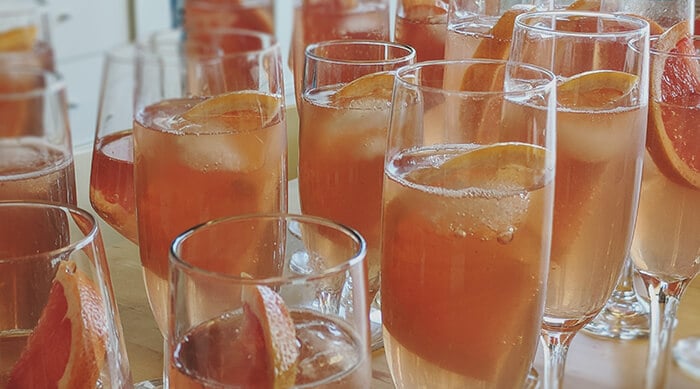Most bottles won’t give away wine nutrition facts without any work on your part. There’s no standardization when it comes to wine, either, so the calories, sugar, and carbs you expect with one wine can vary with the next.
Here’s the basic wine 411: wines are zero-fat, no-cholesterol, and relatively low in calories compared to many alcoholic beverages. (Most aren’t as low-calorie as Surely wine, but we digress.)
Does wine have sugar or carbs? Wine has both sugar and carbs, but it can still have a place in most diets if you’re sipping wine in moderation.
Note: All nutrition facts we share are based on a standard serving size of wine. That’s 5 ounces. We’re not trying to kill your buzz. That number comes straight from the USDA.
Table of Contents
Red Wine Nutrition
Red wine is the wine of choice for many wine drinkers thanks to its antioxidant content. We’ll get into that later, but for now, let’s dive into red wine’s basic nutritional value.
At a glance:
Calories
The calories in red wine vary a little by varietal. Generally, red wine calories hover around 120-125 calories per glass. The higher the alcohol by volume (ABV), the higher the calorie count.
Carbs
Red wine has more grams of carbohydrates than some dry white wines or sparkling wines, but many keto dieters still prefer red for the antioxidants. Pinot noir has the lowest carb count among red wine varietals.
If you’re watching your gluten intake, beware. Some winemakers use fining agents, enzymes, and other additives after fermentation that contain gluten. If you’re a celiac, seek out gluten-free wines.
Sugars
Sugar in wine is naturally-occuring. Winemakers add yeast to eat up those sugars and create alcohol during fermentation. Any leftover sugars are residual sugars.
Is there a lot of sugar in wine? These is not a lot of sugar in dry wine. Sweet wines and fortified wines contain more sugar. Lower-quality red and white wine may have added sugars to adjust for flavor.
Most red wines only have about a gram of sugar per glass. Bolder reds with a higher alcohol content can have up to 2 grams of sugar, as alcohol and sugar (and carbs) are all linked.
Sodium
Sodium in all wine varietals comes from interaction with salt during the winegrowing and winemaking process. Red wine is a low-sodium beverage and unlikely to raise your blood sugar when enjoyed in moderation. Most varietals have about 6 mg of sodium per serving.
White Wine Nutrition
White wine is a touch lighter on the calories than red wine, with fewer carbohydrates. Wine drinkers on various diet plans often reach for white wine for those positive stats.
At a glance:
Calories
The number of calories in white types of wine differs a little by varietal. Generally, there are between 119-123 calories in a glass of white wine.
Carbs
White wine is considered a low-carb wine. Most varietals only have about 3 net carbs per serving. If you really want to limit your carbs, seek out the bubbly stuff. Dry sparkling wines and champagnes only have about 2 net carbs per glass.
Sugars
Go for dry wines if you’re looking for low-sugar varietals. Most dry white wine only has about a single gram of sugar per serving. Sweet dessert wines can have as much as 7-8 grams of sugar per serving.
Sodium
White wine is considered a low-sodium beverage with only around 7 mg of sodium per glass.
Rosé Wine Nutrition
Rosé wine’s nutrition facts mirror the varietal used to make your favorite chilled pink drink. That hue comes from interaction with red grape skins, so a rosé resembles a red wine more than a white. That means you’re getting some of the red wine benefits with a rosé wine.
At a glance:
Calories
Rose wine is a higher in calories than most white wines at about 125 calories per glass. Sweet pink wines like moscato have more calories.
Carbs
A sparkling or dry rosé is a low-carb wine with about 2-3 net carbs per serving. The sweeter the rosé, the higher the carb and sugar content.
Sugars
As with your wine carbs, the sweeter the rosé, the higher the residual sugars. Pink moscato is in the very sweet category of rosé wines, packing at least 7 grams of sugar per glass.
Sodium
Rosé is low-sodium, with only around 5 mg of sodium per glass.
Other Nutrition in Wine
Is wine a healthy drink? Wine is considered a healthy drink compared to other alcohols when consumed in moderation. The antioxidant activity in red wine in particular puts it above beer and spirits. All wines contain some level of vitamins and minerals, too.
Vitamins & Minerals
You shouldn’t make wine your main hydration source, but wine in moderation also gives you a boost of vitamins and minerals. A glass of red wine includes the following:
- Calcium: 11.8 mg
- Magnesium: 17.6 mg
- Manganese: 0.2 mg
- Niacin: 0.3 mg
- Phosphorus: 33.8 mg
- Potassium: 187 mg
- Vitamin B6: 0.1 mg
Antioxidants
Wine drinkers consider red wine the healthier wine thanks to its resveratrol content. Resveratrol is a polyphenol that boasts anti-inflammatory properties linked to a reduced risk of heart disease, healthy cholesterol levels, and improved longevity.
A glass of red wine is also higher in flavonoids. These antioxidants are linked to health benefits like improved memory as you age and a reduced risk of blood clots. The thing is, red grape skins are just as good as red wine if you’re looking for that antioxidant boost.
What is the difference between wine and grape juice? The main difference between wine and grape juice is that wine is an alcoholic beverage. Wine also has less sugar and fiber, fewer carbs, and is lower in calories than grape juice.
Protein
How much protein is in wine? There is not much protein in wine. Most varietals contain just 0.1 grams of protein in a standard serving size.
What’s the Healthiest Wine?
If you’re choosing a conventional bottle of wine, red wine is a healthier option than white for its antioxidant activity. If you’re watching your wine calories, sparkling wine may be the way to go.
It will always be healthier to drink less than to drink more, though. Whether you’re trying to lose weight or just want to test out wine alternatives, Surely wine is here for you.
Our wine is low-calorie — our alcohol-removed pinot noir is just 50 calories per 8 ounces — while still tasting like traditional wine. Need something low-sugar? Our non-alcoholic brut has 0 grams of sugar.


![Wine Storage Temperatures [Basics + Best Practices]](https://dropinblog.net/cdn-cgi/image/fit=scale-down,width=700/34240221/files/featured/Wine_Storage_Temp.jpg)

![Does Wine Freeze? [How It Works & What To Do With Frozen Wine]](https://dropinblog.net/cdn-cgi/image/fit=scale-down,width=700/34240221/files/featured/does-wine-freeze.jpg)